Forest & Shade Tree – Insect & Disease Conditions for Maine
In this Issue:
We are pleased to report we have filled two Conservation Aide vacancies in the Forest Inventory Unit. Frank Driscoll filled the position out of Lincoln as of June 21. Frank is a recent graduate of Colby College in Waterville with a degree in Environmental Science. Frank enjoys baseball and was a captain on Colby’s baseball team. Nick Alpeza joined us in the Conservation Aide position in Fort Kent on July 6. He is a recent graduate from Unity College with a BS in Wildlife and Fisheries Management and minor in Sustainable Forestry. He enjoys fishing, running and hiking. Our Forest Inventory Unit staff spend their days measuring plots that are part of the national forest inventory. As they travel to plots, they keep their eyes peeled for insect and disease issues of concern and they occasionally assist with Insect and Disease Management projects.

Browntail Moth (Euproctis chrysorrhoea)
Beginning the week of June 27th we began observing emergence of the adult browntail moths (BTM). With the adult moths out in force, it is worthwhile to note the potential for human-assisted moth movement on goods/vehicles (including trailers and campers). BTM adults, in addition to being very strong flyers, are also good at hitchhiking rides, which is one of the ways BTM can be dispersed great distances. We encourage you to check for and remove BTM before leaving infested areas, and upon arrival at your destination. Active management of the adult moths is not recommended.
We have seen some recent activity on social media proposing light traps to “eradicate” BTM. We often get asked if light traps or bug zappers are effective at controlling the adult moths and the answer is a resounding no. We have had folks try this method in the past and we usually hear back from them in the winter noting they have more BTM winter webs in their trees, particularly those around the lights. It is mostly males that are drawn directly to the lights with the females hanging out on host foliage outside of the reach of the light. Unfortunately, it is the females that are crucial in keeping the population levels high, so killing just the males won’t really make a dent in the population, especially in heavily impacted areas. Additionally, many of the parasitic flies and wasps that attack BTM are also drawn to light, particularly bug zappers, reducing their impacts to BTM populations. At this time of year, we recommend keeping unnecessary outside lights off between nine and midnight from now until mid-August to avoid attracting more adult BTM to your yard.
Female BTM tend to lay egg masses on host foliage. When buying or moving plants, please be aware that there may be BTM egg masses on them. Inspect plants and scrape any detected egg masses off before bringing the plants home. From what we understand, this is how BTM was transported to the US in the first place, on rose bushes.
Image: BTM adult hitchhiking a ride on a vehicle at a gas station.
|
Fall Webworm (Hyphantria cunea)
The webs of native fall webworm caterpillars are becoming quite apparent. These are frequently mistaken for browntail moth (BTM) webs, and given the abundance of the latter this year, jumping to that identification is very understandable. As eggs of BTM hatch and feeding commences, it will become trickier to tell the two apart.
In the Bangor region at this time, fall webworm webs are generally already more than six inches across, and many caterpillars already exceed half inch long. In general, that is larger than BTM caterpillars will get before they enter winter dormancy. Although both species feed communally, the fall webworm feeding appears more haphazard, while, especially early on, the BTM caterpillars will feed in a methodical, directed fashion on leaves along infested branches. According to observations, BTM eggs have not yet hatched in the Bangor region.
Fall webworm caterpillars are also hairy, but encounters with them generally do not cause an allergic reaction. Their feeding damage begins in July and can continue through September. Despite this long feeding period, their long-term impact on tree health is minimal. Control is generally not warranted, although many people are not happy with the appearance of trees infested with fall webworm. Where management is desired, physical removal of webs, wrapping webs and caterpillars on a forked stick or a long pole with a nail in the end is an effective approach.
 Images: Fall webworm activity as of July 19 on ornamental hawthorn in Old Town, ME
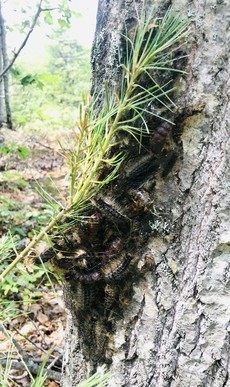
Lymantria dispar (formerly gypsy moth)
Note: In June 2021 the Entomological Society of America discontinued gypsy moth as an approved common name for Lymantria dispar as part of an effort to remove offensive and derogatory language from insect common names. We’ll begin using the new common name as soon as it becomes established, but for the time being we’ll be referring to this insect as Lymantria dispar or L. dispar except where it may cause confusion regarding regulations or pesticide labelling.
At the release of our last conditions report, an impressive display of Lymantria dispar caterpillar damage to trees in Maine and surrounding areas throughout New England was just beginning to develop and be noticed. Shortly after release, the phone calls began pouring in and we became well aware of areas with significant damage, most notably in southern Oxford County (Bethel, Brownfield, Fryeburg, Lovell) and the Canton/Jay area (Oxford County) as well. One of the most interesting things about L. dispar is that outbreaks tend to be synchronous over large geographic areas. In addition to other parts of New England, this insect is also causing problems in the upper Midwest in 2021, especially in the lower peninsula of Michigan.
Many Mainers have been so preoccupied with the woes of browntail moth that L. dispar seemed to come as a surprise, however this periodic pest returns to Maine on a predictable outbreak schedule of roughly every ten years. The last major outbreak in Maine occurred during the early 2000s, with a peak of 51,500 acres of damage documented in 2002. The next expected outbreak would have come around 2010, but turned out to be insignificant, perhaps another reason for the current situation catching people off guard. Even for those of us who knew this would be coming at some point, this particular outbreak appears to have built more rapidly than anticipated. Although we still conducted our regular annual egg mass surveys in the areas where we typically expect to find larger populations, as well as solicited reports from the public for areas with large numbers of egg masses during winter 2020/2021, the 2021 damage is remarkable considering what evidence we had at hand.
Our aerial survey season is well underway, with L. dispar defoliation damage near the top of the list for mapping priorities. In the core damage area of southern Oxford County and the vicinity, we mapped around 55 thousand acres of damage in late June and early July. We are fortunate that this area does not coincide with large BTM populations, as oaks in particular would not fare well with having to deal with both defoliators in one season. As it is, the L. dispar damage has occurred during a period of droughty weather, and so this will take an additional toll on trees. As we often see, trees in heavily affected areas should begin to put out a second set of leaves now that caterpillar feeding has ceased. Those concerned that their trees are already dead should wait and observe to see if leaves do reflush, before taking more drastic measures like tree removal. At this point in the season, adult moths are emerging. They will mate and females begin to deposit egg masses on trees and other surfaces. Even if they won’t hatch until next year, it’s never too early to begin inspecting all recreational equipment you might be traveling around the state with for egg masses to remove, since trailers, campers, and RVs are all favorite places for female moths to lay eggs.
Image: An unsightly group of Lymantria dispar caterpillars, now finished feeding, clustered together in a suitable location to begin the pupation process during early July in Millinocket, ME
|
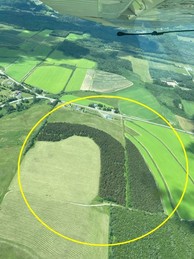
Spruce Budworm (Choristoneura fumiferana)
Like Lymantria dispar, many reports of spruce budworm (SBW) activity came in right after the release of our last conditions report, adding to the mounting evidence of increasing populations of SBW in the northernmost reaches of Maine.
The end of June was a mad dash for pheromone trap cooperators to get their traps installed before the SBW moth flight period began, which was completed just in the nick of time. We know this thanks to our two automated SBW traps in northern Maine, which we introduced in the last conditions report (for a refresher on how these work, check out CFRU’s latest SBW video). The first Maine moths in 2021 were captured on the night of June 20–21 in Stockholm, the first night the trap was in place. The Stockholm trap and New Canada trap then both captured moths on the night of June 21–22. Considering these data, and modelling from Canadian cooperators, we may encourage trap placement earlier in future seasons. There was not much we would have been able to do about this in 2021 due to manufacturing delays for necessary trapping materials, but this will certainly be a goal for improvement in 2022. Regardless, we thank our pheromone trap cooperator network for all of their efforts in getting traps in place in a hurry as soon as they were received.
Because we already knew of several areas in northern Maine where SBW defoliation has been documented on the ground in 2021, it came time to take to the skies and see whether or not we would be able to view SBW damage during aerial survey. We had this same question in 2020, to which the answer was thankfully no, indicating damage remained very light and limited. With our first aerial survey mission targeting SBW under our belts, it appears the answer has changed in 2021. We started by flying over areas with known defoliation to calibrate our search image, since SBW damage has not been observable from the air for several decades now. The damage, though still very subtle to see and difficult to photograph from the air, appears circled in the included photographs. Some polygons mapped as unknown damage in spruce and fir may also be attributable to SBW. These will be ground-truthed to confirm that the damage is in fact from SBW and not some other cause. This first flight was centered over the Fort Kent and New Canada areas, but unfortunately had to be cut short unexpectedly due to a malfunctioning fuel gauge in the airplane. We hope to have additional flights over other areas in northern Maine soon where limited SBW defoliation has been noticed during ground surveys and will provide an update on this survey once results are compiled. Finally, while still not out of the question, it does not appear that Maine has received any massive influxes of migrating moths in 2021 to date like in 2019.
|

Images: Circled in yellow are a few examples of subtle crown discoloration in balsam fir stands known to be affected by SBW in 2021, representing the first signs of defoliation damage visible during aerial survey since the 1990s
Emerald Ash Borer (Agrilus planipennis)
There is not much to report on emerald ash borer (EAB) at this point in the season, with no new detections outside of Maine’s currently regulated areas in 2021 to date. We remain busy with monitoring, however, and are currently performing our mid-season checks of our purple prism traps (PPTs). A few samples of native species in the same genus as EAB have been collected to confirm their identity, however no EAB have been detected on PPTs at this point. Due to a national issue with manufacturing new PPTs in 2021, we did not receive the 200 traps as we had originally hoped for. Instead, about 160 older stock PPTs have been gathered from here and there to create a somewhat reduced monitoring program this year. Despite the shortage, we still have good coverage in the areas bordering the regulated areas and continue our monitoring efforts through use of the girdled trap tree program.
In EAB biocontrol news, parasitoid releases continue regularly at several sites in the regulated areas of Maine where EAB is already established. We’re also now monitoring for parasitoid establishment at release sites using a variety of methods. These include placing bark samples in rearing tubes to monitor for Oobius agrili adults emerging from parasitized eggs, and yellow pan traps placed in the field to attract adult Spathius gallinae and Tetrastichus planipennisi. Samples collected from yellow pan traps are examined under a microscope to search for these tiny insects, however none have been recovered in the early stages of this new project. Once parasitoid establishment can be documented, populations are expected to sustain themselves and priorities for new releases can then be shifted to new areas, increasing our overall coverage around the state.

Hemlock Woolly Adelgid (Adelges tsugae)
Remember that bizarre story about beach-goers in Southern Maine going home with stained and blackened feet? Well, there’s a new plot twist – it seems that the billions of tiny insects washing up on our beaches were none other than hemlock woolly adelgid (HWA) adults.
When we first received samples of the insects from Wells Beach, we weren’t quite sure what they were. Once we saw them, our original sight-unseen hypothesis that they might be a species of kelp fly went right out the window. These tiny insects were clearly true bugs and had two pairs of wings, immediately disqualifying any sort of fly. Karen Coluzzi, in the Cooperative Agricultural Pest Survey program, initially suggested Adelgidae, which was confirmed by USFS. We sent a sample to Nathan Havill for DNA-barcoding and after several inconclusive results from the deteriorating sample, a clear read came back with a clear answer – these weren’t any of our other common native adelgids, but the invasive HWA.
Many adelgids have complex life cycles with multiple forms, including both winged (alate) and non-winged forms. In its native range, HWA has multiple host trees, and the winged adults are those that leave hemlock trees to go in search of certain spruce species, which serves as their primary host species. In North America these particular spruce species are absent, so the good news is, this life stage is a dead end. Many insect populations undergo dramatic behavioral changes when densities become high enough (e.g. locusts, which change from a harmless, solitary phase to the gregarious, migrating swarms when population densities reach a certain point), including HWA. We knew from cooperators across the region that HWA populations are particularly high this year, so while production of alates is not necessarily a surprise, production of this many alates certainly was. This is the first time in memory that managers engaged in figuring out this puzzle have seen such enormous numbers of HWA in this form.
In a year where it seems like pest insect numbers are all exploding simultaneously, it appears to be no different for HWA. These insects are one of the few pest species that does actually fall victim to extreme winter temperatures, but moderate winters lately have undoubtedly aided in increased winter survival rates wherever they occur in coastal New England. Since HWA reproduction is asexual, we won’t be able to gather any specific locality information despite having access to the genetic information of the HWA samples collected for DNA barcoding. It’s likely these were blown out to sea from a large geographic area and then concentrated and deposited together on New England beaches via ocean currents.
As for staining people’s feet, things make a bit more sense now. Those familiar with early American history will remember the pivotal role hemlock trees played in the tanbark industry. The same tree tannins originally used for tanning leather, which are ingested by feeding HWA, are likely the direct cause of the undesirable foot discoloration.
Image: One of an innumerable amount of alate (winged) adult HWA to wash ashore on the beaches of southern Maine earlier in 2021
|

Drought
Maine’s moisture deficit conditions continue mostly statewide. Only one week ago, the entire state was under abnormally dry to severe drought conditions. Following recent rain events throughout the southern half of the state, the U.S. Drought Monitor map of Maine has shifted to more area under the abnormally dry classification and a much smaller proportion of the state in moderate to severe drought. Thankfully, the southern half of Aroostook County and almost all of Washington County are no longer under a drought classification of any kind. However, classifications aside, Maine has been dry this year and this has impacted our forests and trees and their ability to grow and be resilient to native and non-native forest pests. Recent rains do not erase the impacts of acute stress trees experience due to water deficit. The effects of drought in 2020 and 2021 will likely be seen in the years ahead in the form of dieback, decline and susceptibility to secondary pests in the trees and forests of areas most significant impacted by drought.
Image: U.S. Drought Monitor map of Maine, July 13, 2021.
|
Beech Leaf Disease (Litylenchus crenatae mccannii)
Beech leaf disease (BLD) continues to be reported and confirmed in the Midcoast area from Belfast to Appleton, to Union and south to Rockland. So far the disease has caused varying levels of defoliation and leaf deformation, but more serious impacts have not yet been observed. However, this is a new disease in Maine and continued observation will be important to understanding the impacts of this disease here. Reports from outside of the earlier described area have thus far been the result of BLD look-alikes like woolly beech aphid and erineum galls, both pictured below. Woolly beech aphid presence is indicated by curled leaves and whitish fuzz on leaf undersides. The leaves may be chlorotic (yellowish), especially at the leaf margins (edges). Erineum galls, caused by eriophyid mites, cause leaf surfaces to be raised and sometimes bumpy, with a thin felt-like layer of tissue on the leaf underside. Younger erineum may be light green to yellow, and may turn reddish with age. It is important to note that woolly beech aphid and erineum galls (and other common disorders of beech leaves) have been documented on trees also infested with BLD. Thus, we continue to urge the public to keep reporting symptoms of beech leaf disorders (and all unusual disorders of trees in general) and welcome reports with pictures and site and location descriptions. Potential BLD reports can be sent to Aaron.Bergdahl@maine.gov or by calling (207) 287-3008. General reports of tree disorders can be made using the tree ailment form, by calling (207) 287-2431 or emailing us at foresthealth@maine.gov.
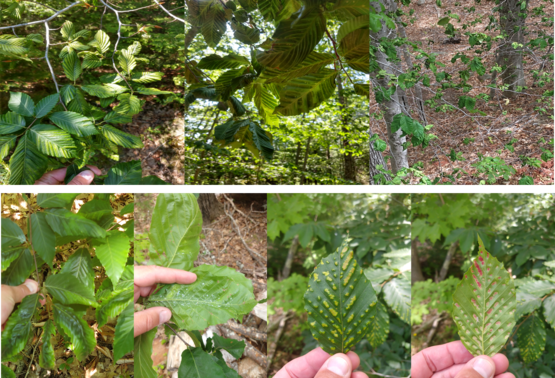 Images: (top row) Beech leaf disease symptoms; (bottom left, two pictures) Woolly beech aphid symptoms on the leaf top and bottom; (bottom right two pictures) Erineum gall symptoms on the leaf top and bottom.
Fir Broom Rust (Melampsorella caryophyllacearum)
Reports and observations of fir broom rust on balsam fir in late June are the reason this disease is included in this July report. Often confused with dwarf mistletoe, this is a heteroecious rust, meaning that it requires another unrelated host species to complete its infection cycle. In the case of fir broom rust, that alternate host is the common plant, chickweed. Numerous yellow spore pustules appear on the needles of the witches’-brooms formed in response to infection in summer and spores from these will infect chickweed. Orange spore pustules can be seen on chickweed leaves in spring and summer, and spores from these will infect fir trees. Broom formation in fir causes growth reduction, branch deformation and dieback and has aesthetic impacts as well. Pruning the brooms out of trees as soon as they are noticed is the best method of management, since eliminating the ubiquitous chickweed across a large area near potentially impacted trees is difficult.
 Images: (left, middle) Fir broom rusts on balsam fir; (right) A close-up of broom growth showing the spore-producing structures that form underneath the foliage (credit: Kristen Puryear).
Oak Anthracnose (Apiognomonia errabunda)
A report of severe oak anthracnose in Sedgewick was confirmed with an on-site visit in late June. Oak anthracnose is a foliar disease of oak that can range in severity due to the phenology of budbreak in specific trees and the timing of spore release – which is closely related to moist weather conditions. If heavy infection occurs when leaves are small and beginning to expand, the lesions caused by the fungus can result in severe leaf damage making sections of leaf dry and papery (damage to the new, succulent leaf tissue by the fungal lesion is amplified as the leaf expands). In these cases, oaks typically drop their leaves and refoliate. If infection occurs after leaves have expanded and the waxy cuticle of the leaf has formed, damage is significantly less, seen as simply small brown dots on leaves that expand slowly as the season progresses. Due to the dry weather this spring/early summer, which is not conducive to infection by most fungal leaf diseases, anthracnose diseases were predicted to be uncommon this season. However, maple anthracnose reports and observations have been very common this summer and anthracnose of oak, birch and ash have also been observed in several locations across Maine. There can be adequate available moisture for infections in coastal areas that experience frequent heavy fogs, but this could only explain some reports of anthracnose disease.
Luckily, anthracnose diseases like oak anthracnose are rarely a serious threat to tree health (although it is aesthetically alarming and can be a significant stressor if infections occur over several years). However, this symptomology of anthracnose disease is a good reminder to watch out for a much more serious pest of oak, oak wilt disease, which has not been found in Maine but is a focus of early detection efforts. Like with oak anthracnose, oak wilt also results in leaf discoloration and summer defoliation of oaks, with symptoms developing in June through September, although the height of symptoms usually occurs in July and August. But unlike oak anthracnose, oak wilt can kill a tree in as little as one month following infection, and once a tree is infected, there is no cure. Efforts toward early detection of oak wilt are important, which is why we value reports and observations by the public. If you notice wilting of oak foliage or oak leaf drop in summer, please report the occurrence to Aaron.Bergdahl@maine.gov, (207) 287-3008.
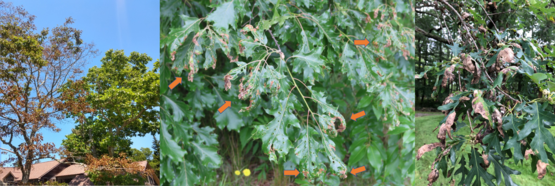 Image: (left) The red oak tree on the left is severely impacted by oak anthracnose, while the red oak on the right is only lightly impacted, likely due to the individual timing of leaf flush by these genetically different trees and the convergence of a moisture event and infection period of the oak anthracnose fungus. (middle) Close-up of leaves impacted by oak anthracnose fungus (note the dead, papery sections of deformed leaves are the result of infection by the oak anthracnose fungus. The holes in the leaves are from oak leaf shothole miner). (right) Oak anthracnose damage on white oak (Credit: Kyle Rosenberg, City of Bath)
An extreme hail event in summer 2020 in the Sanford area caused heavy damage to trees that is still very apparent in summer 2021. Some trees have died due to the damage, while others suffered heavy dieback of large proportions of crowns and major branches. The wounds that occurred on branches may have served as infection entry points for canker and decay fungi, the impacts of which may be seen in future years. As trees try to recover, dormant (adventitious) buds have become active under the bark of impacted trees and have emerged, flushing new leaves. This results in compact clustering of foliage close to the main stem of trees. This damage has been compounded by the lack of rain, which impedes the recovery of trees from this type of damage. Additionally, any other pre-existing disease issues, for example white pine needle damage, will further stress trees in the impacted area. Looking ahead, the future health of these hail-damages trees is uncertain. Some mortality will continue to occur and other trees will be removed/salvaged due to poor health and aesthetics.
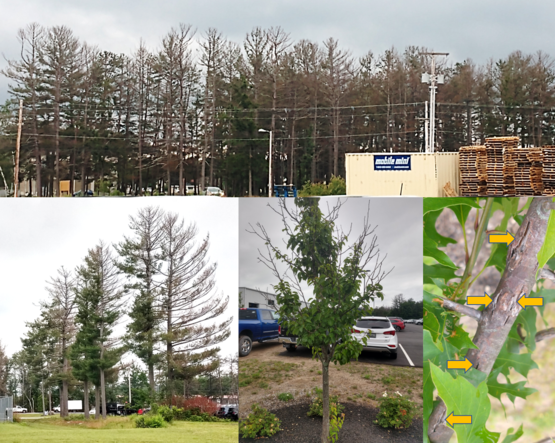 Image: (top) A stand of eastern white pine trees heavily impacted by the 2020 hail event, pictured in June 2021, with some dead trees and others heavily damaged; (lower left) Damage to white pine trees indicating the storm’s direction with less damage on the leeward side; (lower middle) An ornamental pear tree struggling to recover from severe hail damage; (lower right) A close-up of hail damage to a branch of a sapling oak, indicating some healing.
Conditions Report No. 4, 2021
On-line
Department of Agriculture Conservation & Forestry
Maine Forest Service – Forest Health and Monitoring
Contributors: Aaron Bergdahl, Allison Kanoti, Mike Parisio, and Thomas Schmeelk
Unless otherwise noted, photos by Maine Forest Service, Forest Health and Monitoring, DACF
|